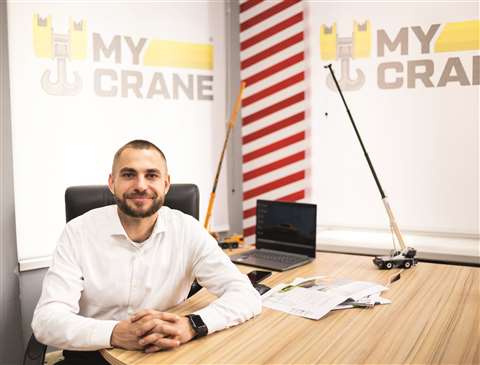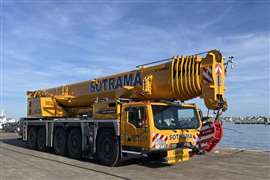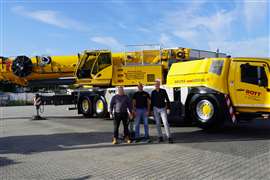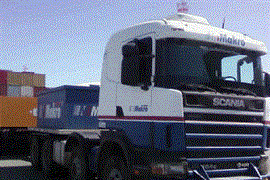INTERVIEW: MyCrane’s Andrei Geikalo on digitalisation
02 March 2022
ICST spoke to Andrei Geikalo, founder of digital crane rental platform MyCrane, to hear his journey to digitalisation.
Andrei Geikalo’s new digital platform aims to simplify the crane rental procurement process. The Dubai-based MyCrane founder took time out of his busy schedule to explain it to ICST.
 MyCrane’s founder and director Andrei Geikalo (Photo: MyCrane)
MyCrane’s founder and director Andrei Geikalo (Photo: MyCrane)
Users enter details of their lifting requirements into MyCrane and receive personalised crane rental quotes from a range of registered crane providers, removing the need for users to contact multiple equipment providers. The company says its online request form is designed to ensure users receive directly comparable quotations. In developing the site Geikalo, a former commercial director at heavy lift and transport giant Mammoet, drew on his industry experience.
Tell us a little about yourself. How did you get into the crane industry?
Andrei Geikalo: Everything started with my love of cranes. I’m originally from Kazakhstan and I studied at the Moscow state technical university named after Bauman in Russia – for me, it’s the best in the world. It has a huge 190-year history of expertise in everything from nuclear science to aviation technology.
My studies lasted six years, during which time I gained a technical education in the robotics and automation systems faculty. It deals with intelligent lifting, transport and construction equipment and machinery.
I really do love cranes. So, during my education I googled the best heavy lift company in the world and found Mammoet. I knocked on the door and asked if I could come to work for a summer internship and that’s how I got started. I was a student working as a mechanic in the yard, helping maintain and assemble cranes. When I graduated I started as an engineer and continued and progressed into operations.
I worked in operations for a number of years, learning how it works on site, and then I began tendering for projects, pricing for certain equipment. Then I worked in sales, and became a sales director in 2015, working across the largest projects in Russia with everything from offshore works to gas processing and LNG plants.
My last two years at Mammoet I was also working as deputy general manager, as well as in sales. I wanted to learn more about the management of a company and what that involved. I studied for an MBA that focused on entrepreneurship and management. Mammoet is an outstanding company - it showed me the crane market, from both sides of the crane procurement process. I could see it from a client’s side and from the supplier’s point of view – the full rental process. I could see the bigger picture and the future of the market.
What are the problems with the existing crane rental procurement process?
The crane rental process is so outdated and complicated and challenging for all parties involved, both clients and suppliers, from the very start.
When starting any project, a construction company needs to define what crane they need. Sometimes they will have their own engineers to decide this, or it is outsourced but it is usually done using crane charts. Then they need to build up an enquiry to go to the market. These are the first challenges – it takes so much time. They need to build up a vendor list and write a technical request.
“The current crane rental process is so outdated and complicated, for everyone, from the very start.”At this stage, even an experienced client in an experienced company can still miss something because there are so many parts of the enquiry to remember. The whole philosophy of MyCrane is to understand the client and their needs fully. We have a deep knowledge and expertise in the industry so we can help with this.
The third step always wastes a massive amount of time. It is the supplier’s clarifications: calls, emails back and forth as parts are missed and so on. That’s why at MyCrane the client just needs to fill in a simple unified enquiry form and it goes directly to the database of the suppliers who have registered cranes.
The fourth step is receiving a quote. Quotes come in from everyone in different formats. Everyone has different layouts. Some have included fuel, some have not.
At Mammoet we called this stage ‘comparing apples with apples’ but you have to contact and clarify with everyone by phone and-or email, or even meet them in person, though this was more common pre-pandemic. You’ve already got all the information on the form with MyCrane.
You have compared and aligned everything, and want to award a company with the contract. Any decent business will want to do due diligence and request documentation such as charters and bookkeeping, etc. If this fails, you have to go back and choose a different offer. You might have a shortlist of suppliers, a top three but, even with one, the contract negotiation stage comes and you have to have the contract approved by yours and the supplier’s legal and finance teams, etc. Finally, the contract has been signed and the time comes for the mobilisation of the crane to site and the start of the execution. To mobilise to site, there are some challenges as well, like passes to the jobsite for equipment and people, permits and so on. You need to send by email documentation for people, cranes, trucks and more, for the final stage – the execution of the crane’s work.
There can be discrepancies in the number of hours the crane has been working, which always needs to be agreed. Bookkeeping receives the time sheets and acts of acceptance, it gets approved and then the work is paid up. This is the dream scenario and it rarely happens. MyCrane aims to make this more transparent and all documents can be uploaded and stored at our website.
Many people in the industry know about this process, its complications and its issues but they are too busy to fix it, to see the bigger picture. They just want to crack on and get paid. They simply cannot raise their heads above and see. What can they do? If they don’t have resources, time or energy, it doesn’t matter how much enthusiasm they may have.
What are MYCRANE’S goals?
Lockdown happened and finally I had time to raise my head up and see it. I had the resources and knew it was time. I’m not interested in fame or to monetise outrageously. I know the benefits of the digital world. We can also see the successes in B2C, so why not B2B? It would save time, money, energy and resources. I know the crane industry and I knew it would help clients.
In this industry, there are a lot of middle men. There are also companies who don’t care enough about quality, I can’t blame them, that’s the market, but that’s what we wanted to change.
The industry has been slow to digitalisation. In Russia, for example, more than 70 per cent of companies don’t even have a website. You can’t find them.
To understand and fulfil the needs we need to unite this community. Not the middle men but the real crane companies. We register the companies, the real owners of the cranes. Then we check the documentation. That way, we can say to clients, we have done the due diligence already and we have the real information. We have the correct information for each country’s requirements. We are up to date and have everything. We can moderate the users, and each user is a client for us. Our clients are gods for us.
All the documentation is then stored in our system. A client puts an enquiry into our system and the relevant people receive it. The client can then check out their profile and, most importantly, their rating, which is based on previous jobs.
It’s more efficient using the MyCrane platform as there is a full report available to download. You miss out on all the lawyers, legal and finance. It’s much quicker for a decision maker.
We want MyCrane to be equal to quality. Eventually, we want it to be that if a company is on MyCrane, then they are legitimate. We believe that MyCrane’s reports and ranking will be a benchmark in the market.
What other services do you provide on the platform?
We want to unite the global lifting community and we have three main pillars: the platform itself, marketplace, MyCrane selector and the additional services.
Marketplace is for when you need to maintain your crane, when you need spare parts and rigging equipment. And when you need good people to operate and fix it. It can all be listed on our marketplace.
Then we want it to be easy to select the right crane. That’s why we have developed the MyCrane Selector. It will be free to use.
We want to be involved in a project from the beginning. There’s a whole load of areas we want to help, from transportation of cranes to site, surveys, legal support, engineering, etc. We’re independent as we don’t own cranes. Being impartial means we can help the client to find the best technical solution as proposed by the market.
Cranes are big pieces of equipment and take up a lot of space on site, so you have to plan properly for this and see what might block it or cause issues down the line, otherwise there are extra costs. We want to help clients avoid mistakes and choose the best solution.
Is the crane industry resistant to this type of digitalisation?
Now? No. Initially some people don’t really understand the concept but once they have seen the solution it’s a no-brainer. The crane budget in a construction project is around 15 to 20 per cent, so it’s a huge portion, and it’s always considered. We have found there is no barrier to digitalisation for crane procurement, people like it. Going digital is happening everywhere in the world, not just cranes, and people can really see what benefits it brings. It’s more the unknown for digital solutions that makes them hold back.
And it seems that throughout the pandemic, we are learning to use more and more technology and digitalisation anyway. The way of working changed dramatically. Some people say, “Oh we were thinking of doing that,” but hadn’t actually got around to it.
What does the future hold?
I’m based in Dubai and our headquarters are here too. We have global plans and ambitions and, in a short space of time, we are really expanding. We’re signing new countries all the time; recently India, next Qatar, announced at the CATME 2022 conference in March, and now we’re really flying. The speed is fast because the industry is ready for it. It is my strong belief that this is the future.
STAY CONNECTED


Receive the information you need when you need it through our world-leading magazines, newsletters and daily briefings.
CONNECT WITH THE TEAM












